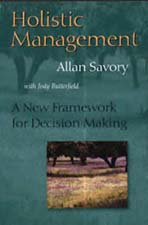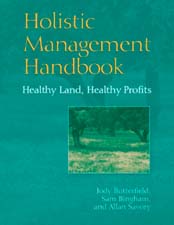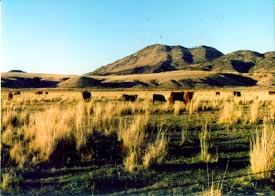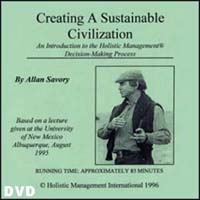Granny's Country Store > Holistic Living > Holistic Management | View Cart

Holistic Management
A New Framework for Decision Making
by Allan Savory with Jody Butterfield
There is a common assumption that cows have a negative impact on rangeland. Cows eat the grass, and the only way for the plants to recover is to take away the animals. Many environmentally concerned people want to remove all livestock from public lands. But the reality, as Allan Savory discovered, is that hooved animals play a critical role in the health of arid rangeland ecology. There is a critical relationship between the soil and the hooves of grazing animals. In seasonal rainfall environments the land rapidly turns to desert without animal impact.
Historically, western rangelands were grazed and maintained by massive herds of buffalo. The important part was not the buffalo, but the sequence of grazing. Predators forced the buffalo to stay clustered in tight herds for safety. Some herds were so massive that observers described them as miles wide and hours or days long in passing. They destroyed everything in their path, trampling grass and sagebrush--every bit of organic matter--right into the soil. Their hooves and urine killed the moss while desirable plant seeds were pounded into the soil to germinate. Old or dead vegetation was trampled into the ground where soil microbes could break it down. The organic litter helped retain moisture for plant growth. Gradually the debris rotted and returned the nutrients to the soil. The roaming bison left the prairie to recover without further interference, allowing for lush and unrestrained growth.

 |
|
Livestock spread out and graze over wide areas--they no longer trample down standing dead grasses from previous years. |
Putting fences across the land and stocking it with cattle creates a new sequence of grazing, which logically has a different effect on the land. Without predators the cattle spread out and graze over wide areas, they no longer trample down standing dead grasses from previous years. This old material blocks sunlight, killing the new growth below. Old vegetation stands for years, slowly decomposing through oxidation and weathering. Valuable nutrients are locked up in the old growth, unavailable for living plants. With fences to keep the cattle contained, the young plants are eaten repeatedly as grazing animals return without allowing the vegetation to recover. Burning the range can accelerate desertification, stealing vital organic matter from the soil and putting it into the atmosphere to contribute to global warming.
Loss of organic matter also results in lack of soil structure, breaking down the granules or clumps of aggregated soil particles that allow air circulation and penetration of water and roots. Raindrops strike the exposed ground, pulverizing and separating the soil, just like you might find under the drip line of a house. The fine particles of silt, sand, and clay dry to form a hard surface crust. Seeds cannot grow through the capped surface, and bare patches develop between the plants. Weeds, brush and grasshoppers thrive in the open patches. Moisture is lost as runoff and may cause floods. Water bypasses the water table and old springs can dry up. Freezing and thawing, plus wetting and drying can also cause the top inch of the soil to become so porous and fluffy that seeds dry out before they germinate.
 People assume that removing the livestock would allow the land to recover, but in actuality, the complete removal of livestock accelerates the process of desertification. We are losing the land right out from beneath our feet, yet few people have even noticed.
Allan Savory discovered, or possibly re-discovered, the important link between hooves and the soil. In his book, Holistic Resource Management, he outlines the ways we can use livestock to restore the health of the land. Savory also puts forth a holistic system for making sound land management decisions, which could literally change the world... if more people knew about it.
People assume that removing the livestock would allow the land to recover, but in actuality, the complete removal of livestock accelerates the process of desertification. We are losing the land right out from beneath our feet, yet few people have even noticed.
Allan Savory discovered, or possibly re-discovered, the important link between hooves and the soil. In his book, Holistic Resource Management, he outlines the ways we can use livestock to restore the health of the land. Savory also puts forth a holistic system for making sound land management decisions, which could literally change the world... if more people knew about it.
Allan Savory's work has been highly influential to my own writing. I bought the first edition of Holistic Resource Management as soon as it came out in 1988. I read it many times over. The new edition, called Holistic Management: A New Framework for Decision Making is even better.
Allan Savory's video Creating A Sustainable Civilization is an excellent way to introduce people to the concept of Holistic thought and management, without over-loading them with details. Every person I have shown this video to was thoroughly stunned by the presentation and message.
Many of Savory's ideas were strongly influential towards my book, Direct Pointing to Real Wealth: Thomas J. Elpel's Field Guide to Money.
Holistic Management Resources available through Granny's Country Store
Special Discount: Save $15.00 when you order the books and the DVD together!
-Please scroll down the page for the "Add to Order" button.-